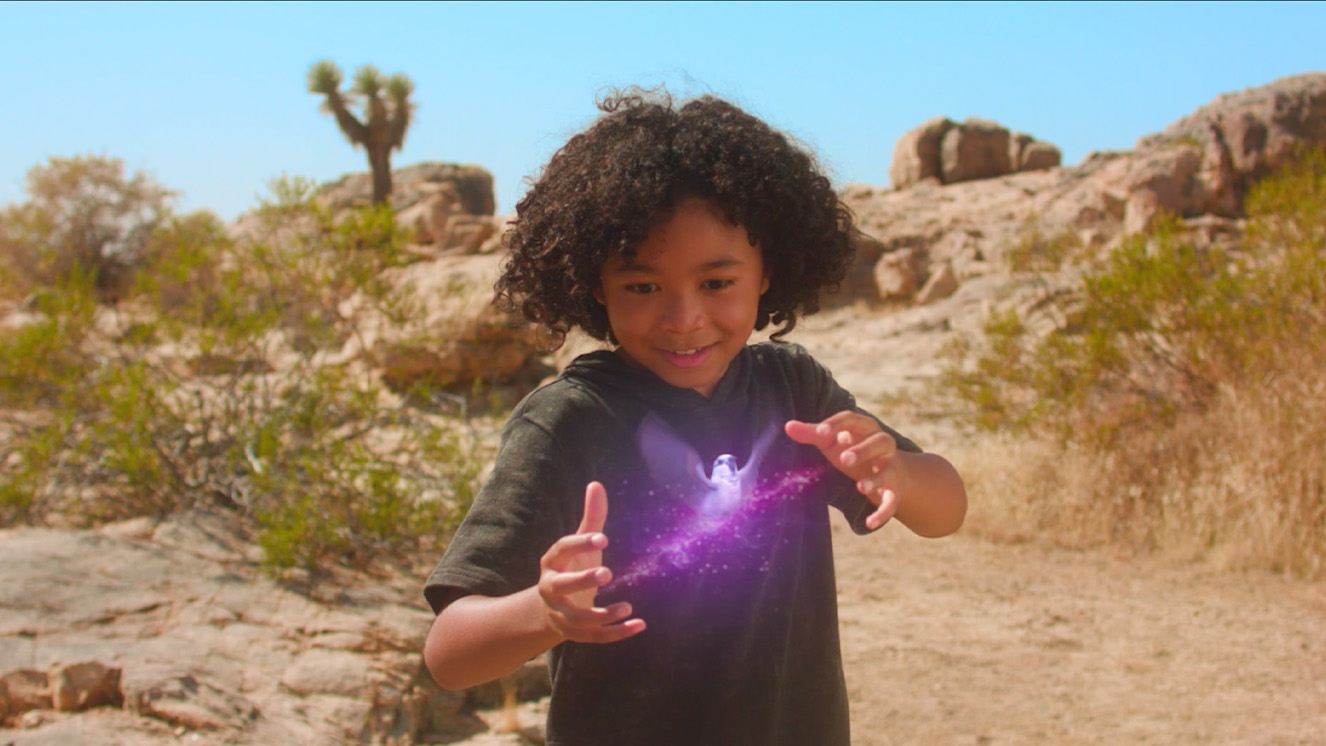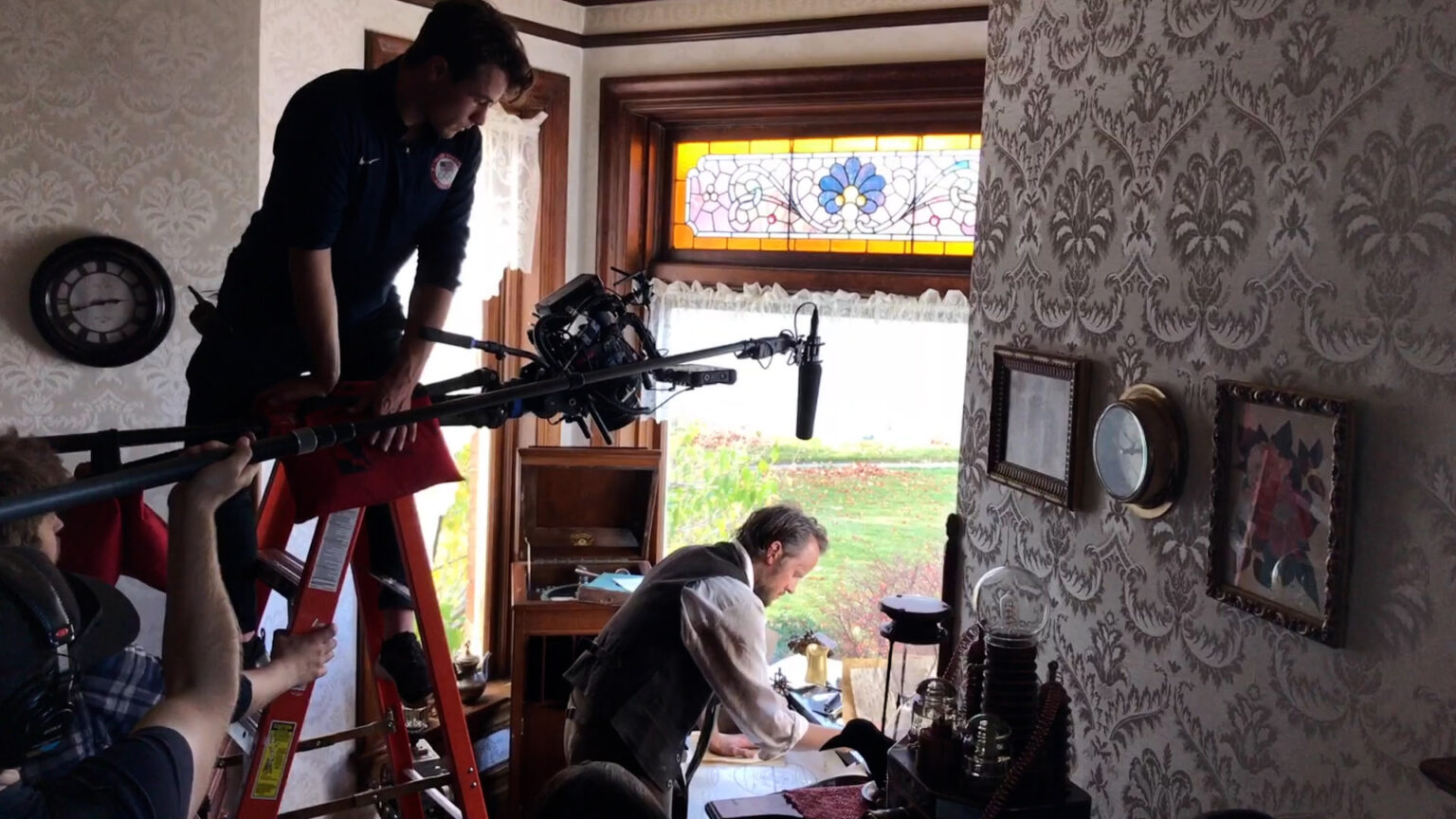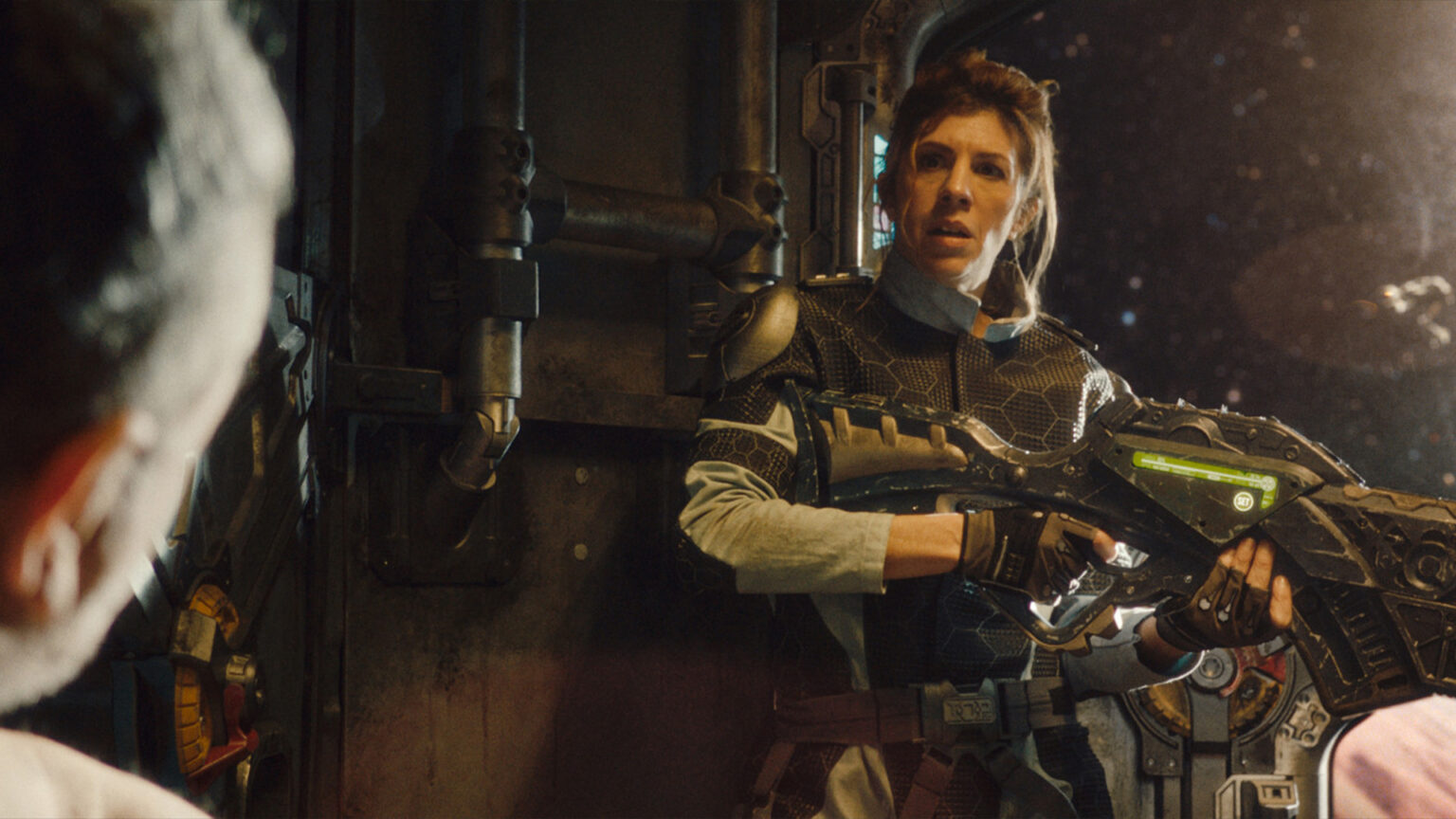Sci-Fi
Desert Sky

In the midst of the global chaos caused by the 2020 Coronavirus pandemic, filmmaker David Hartstone found solace and inspiration in the confines of a small room. As uncertainty loomed, a yearning for escapism and the rediscovery of the enchantment within family bonds and love emerged. This spark of creativity led to the birth of the fantastical world of “Desert Sky,” a short film caught in the crossfire between magic and technology.
Hartstone shared that the idea for “Desert Sky” blossomed from his personal reflections during the pandemic. Transitioning from a cramped 250 sq/ft apartment to the vastness of a 250 sq mile shooting location served as the perfect catalyst to breathe life into a realm of pure imagination. Fueled by ambition, genuine friendships, and a touch of madness, the narrative emerged, offering an escape from the grim realities of the time.
The heart of the desert, devoid of signs of civilization for miles, became the backdrop for the film’s production. Hartstone expressed awe at the level of teamwork, camaraderie, and impromptu decision-making required in such an environment. The dedication of the cast and crew, going above and beyond to contribute to something greater, left an indelible mark on the filmmaker. The experience showcased the grit, determination, creativity, and excellence demanded by the filmmaking process.
The most formidable challenge faced during the production of “Desert Sky” was the unpredictable and potentially deadly elements of the desert.
“No one took that responsibility lightly, nor could we afford to. I’ll never forget setting up for a scene at the base of a mountain on day one of filming, when a sudden torrential wind storm moved in with zero warning. The 50+ MPH gusts quite literally bent the metal of our 15 ft scrims right in half. That’s when we knew Mother Nature was going to be more than a supporting cast member on this film, and she was going to be a diva.”
Reflecting on the journey, Hartstone acknowledged the learning curve and challenges faced as a burgeoning artist. The ambitious project involved elements he had never tackled before, from working with a larger team to directing in a remote desert location.
“Even with only a 15 person cast and crew – I had never worked with a team that large. I had never even directed a movie that wasn’t shot at my own apartment, let alone taking a team all the way out to a remote desert location. And I certainly didn’t intend to make a short film that had more VFX shots than the entirety of the first Jurassic Park movie!”
To those aspiring to enter the world of film production, Hartstone offered a simple yet powerful piece of advice: “Just do it! And don’t be afraid to start small. Go shoot a little scene with a few friends and minimal equipment. Feel it, try it, FINISH it…and then do it again. Push yourself a little further, add in another element, find out what interests you and WHY! The reward is well worth the effort…I promise.”
For those curious about future projects, updates, and news from David Hartstone and the team, they can follow @Seventhhousepro on Instagram. Personal accounts of key figures, @davehartstone and @lexagluck, also provide insights into their creative endeavors.
Sci-Fi
The Time Machine

Ebrahim Ghaeini, the creative mind behind the short film “The Time Machine,” recently shared insights into the making of this 11-minute sci-fi gem. Adapted from H.G. Wells’ classic tale, the film invites viewers on a visual exploration of memory and time, as the Time Traveler returns to London, triggering vivid recollections of encounters with Morlocks in an underground tunnel and his unique bond with Weena, an enigmatic Eloi.
Ghaeini’s journey with “The Time Machine” began with a profound appreciation for classic literature, particularly the works of H.G. Wells, known as ‘The Father of Science Fiction.’ The film, in many ways, serves as an invitation to audiences to delve into the themes of Wells’ iconic story, hoping to ignite a curiosity that prompts viewers to pick up the original book.
““I remember feeling intrigued to dive into his novel to see where this “birth” of science fiction began,” said Ghaeini. “What captivated me the most was how the world I envisioned while reading, was a darker, dystopian world with profound societal and social commentary, in comparison to the existing film adaptations. It’s always fascinating to me when classics carry widespread recognition, yet many are unfamiliar with the story.”
“For example, most have heard of The Time Machine, 20,000 Under The Sea, Dante’s Inferno, Journey to the Center of the Earth, but what are those stories really about? What are the nuanced themes? In a way, my film serves as an invitation, encouraging audiences to explore literature and stands as a tribute to H. G. Wells – a heartfelt ‘Thank You’. It felt only appropriate to keep the film with the same title, as Wells had intended.”

Casting, a crucial element of any film, played a pivotal role in bringing Ghaeini’s vision to life. John Cave (Time Traveler) was chosen for his ability to convey authentic, multi-layered reactions without dialogue.
“John Cave, a close friend and collaborator on previous projects, stood out for his ability to deliver authentic multi-layered reactions. Johns talent came with portraying various facets of “fear” The audience will be immersed and feel fear not from what they see, but from what John perceives. When we see that John is believably afraid, we are too. He carried the film beautifully.”

Stefania Barr, who brought depth to her character Wenna, became integral parts of the storytelling.
“Her reactions on screen are genuine and powerful. I specifically sought someone who could convey ‘heart-break’ in a single gaze, and she exceeded expectations, knocking it out of the park!”

The film’s locations added another layer to its authenticity. Filming at the Heins Mansion in Provo, UT, provided the perfect Victorian atmosphere for the London house scenes. However, shooting in a storm drain at Dimple Dell Park in Sandy, UT, for the tunnel scenes brought its share of challenges, including negotiating the tunnel’s grooves, dealing with the cold November weather, and overcoming technical issues. Despite these hurdles, the end result made the efforts more than worthwhile.

“Securing film permits in parks can be challenging. Negotiating the grooves of the tunnel, avoiding rocks, and running in the dark while dealing with the cold November weather made it an immensely challenging shoot. We encountered issues like losing feed on wireless gear, dealing with water levels, covering graffiti, and even blocking the tunnel entrance at times with duvetyn. Running a generator inside was ruled out due to safety concerns and audio disturbance, so we powered through with an abundance of batteries. Despite the challenges, the base camp outside the tunnel provided some respite and warmth. This location was certainly not for the faint of heart.”

The eerie prosthetics for the Morlocks, crafted by makeup artist Julia Vinha, aimed to capture the subterranean evolution of a race envisioned by H.G. Wells.
“Months prior to filming, we collaborated extensively, examining references, conducting camera tests, and honing the right look. Our discussions focused on portraying the Morlocks as humans who had evolved over thousands of years underground, literally forming their own subterranean race, as envisioned by H.G. Wells. The prosthetics aimed to capture their pale complexion and distinctive large eyes, staying true to Wells’ description.”

Ghaeini’s filmmaking journey with “The Time Machine” proved to be a transformative experience. The decision to craft a dialogue-free film challenged him to convey the narrative solely through visuals.
“One of best pieces of advice I received was the advice to “Show, don’t tell.” Taking this to heart, I challenged myself to craft a talk-less film, relying solely on visuals to tell the narrative. Sure I had Father Wells’ guidance, but it was an invaluable learning experience.”

Beyond directing actors, he explored directing the energy of the film, considering elements such as camera motion, pacing, shot duration, and lighting.
“The Time Machine’ also served as a fun enticing exploration of the VFX world, and realizing the importance of thorough pre-visualization and preparation. These lessons are invaluable tools that I’ll undoubtedly carry forward into my future filmmaking endeavors.”

Ghaeini’s favorite aspect of the production was the collaboration with an incredible team of passionate filmmakers who became a tight-knit group of friends.
“To this day, some of us continue to celebrate Friendsgiving. There’s nothing better than creative storytelling alongside those you love and laugh with.”
As with any creative endeavor, challenges arose. The substantial pile of VFX work awaiting Ghaeini in the editing process, coupled with the role of editor, presented a stressful yet necessary learning experience.
“In hindsight, I may have been a tad over-ambitious. Managing the role of editor was already a significant task, and I further took on the responsibility of completing all the post VFX work. While it was necessary learning experience, it was an undeniably stressful process.”
For those curious about Ghaeini’s future endeavors, his website www.ebrahimghaeini.com and social media accounts, including Instagram @ebbiekg and the film’s Instagram account @thetimemachine.shortfilm , offer glimpses into his ongoing journey in the world of filmmaking.
Sci-Fi
Phase III

In a blend of inspiration drawn from personal experiences and a chilling reflection on the repressive nature of nations like North Korea, “Phase III” is a powerful narrative screening at the Utah International Film Festival from February 12 to 17. This dystopian tale, written and directed by Numark Ricafranca, explores the life of a 13-year-old girl determined to break free from the monotonous and coercive existence of phase II, yearning for a better life in the elusive phase III.
As the film prepares to light up the screens at Maven Cinemas in American Fork, UT, we had an exclusive interview with Ricafranca exploring the origins and challenges faced during the production of “Phase III.”
Ricafranca reveals that the story’s roots lie in his own immigration experience to the United States, emphasizing the abundance of opportunities in the country. Drawing parallels with the restrictive environment of North Korea, the film aims to shed light on the impact of government rules on citizens who have no knowledge of the outside world.
The interview unveils Ricafranca’s favorite part of production—the post-production process. He describes the thrill of piecing together scenes to create a believable dystopian world, highlighting the challenge of conveying the film’s concept during the silent montage sequence.
“The most chilling part of the post-production process is when I started showing people the rough cut and everyone finally understood the concept of the film” said Ricafranca. “But it definitely came with a cost: tons of sleepless nights, countless research hours for room to experiment, and getting used to working in a dark environment.”
Ricafranca recounts the painstaking process of creating the Jeo Language—an invented language integral to the film. This unique linguistic element added complexity for the actresses who had to not only memorize but also understand the language for authentic delivery.
“Not only do they have to memorize it, but they must also understand what they’re saying so they can execute the lines in the sense of what their saying. I initially wanted the language to be French, but as I think about it more, inventing a language adds legitimacy into the creation of the world of Jeo. It took me a month to invent the language with the words, letters, and enunciations.”
Looking back, Ricafranca expresses a desire to consult more with the post-production team during the pre-production phase. “One thing that really takes up a lot of time of our shoot is making the butterflies fly. It never did because we should’ve predicted that the temperature would be too cold for them. The final product of the film ended up creating visual effects for the butterfly.”
For aspiring individuals looking to enter the production space, Ricafranca offers a piece of advice—approach it with full confidence. “Being a production crew is incredibly fun and whenever I see the final product of the film, I always love the element of surprise as I realize that this is actually what we’ve been working on.”
To stay updated on future projects, Ricafranca can be followed on his Instagram page, @numark_ricafranca, and his IMDB page, “Numark Ricafranca.” Additionally, he recommends following the Utah Tech University Film Department, praising the hands-on film learning environment.
“This project was my Senior capstone at Utah Tech and it wouldn’t have been done without them. The film program at Utah Tech is growing and it has a hands-on film learning environment, especially if you are interested in working on a film set.”
Sci-Fi
Dark Cell

“Dark Cell” is set within the confines of an orbital prison, where two seemingly unrelated inmates are confronted by chaos. Panic-stricken guards, armed to the teeth, disrupt their routine, revealing a prison overrun by blood-thirsty, zombie-like creatures. The only means of survival: eject the cell and return to Earth. However, a twist of fate exposes a shocking truth – the cell designed for two now accommodates four individuals. With time ticking away, the inmates must quickly decide who among them will emerge as the fortunate survivors.
Tari draws inspiration from a French TV series, “Braco,” where the intense performance of Alain FIGLARZ ignited his creative spark. The idea of locking two unrelated characters in a confined space within an orbital prison took shape, driven by the need for an ambitious science fiction film with innovative special effects.
“At that time, I wanted to make a science fiction film with ambitious special effects” said Tari. “I immediately thought of locking these two unrelated characters in a confined space because usually, in short films, a “closed set” is often used for obvious cost reasons. The idea of an orbital prison quickly came to mind as only the porthole would allow us to see the outside. So, I thought a 4×2 meter green screen would do the trick. All I had left to do was to write the story with these constraints. I just had to imagine pretenses, twisted situations that are not what they seem. I love twisting a script in every direction and unexpected ending.”
For Tari, every aspect of the production was a labor of love. From the inventive pre-production phase, where he navigated the challenge of creating sets on a budget, to the adrenaline-fueled 6 days of shooting, the director reveled in the dynamic energy and talent of his team.
“I love this energy and these moments where, as a director, you have to make quick decisions. You don’t have time to waste and you must have an answer for almost everything. It pushes you to surpass yourself. My goal, at the moment, is to spend more time on set with larger team shooting a series or a feature film.”
Making films is not as easy as it looks to the casual viewer. “I received no financial assistance whatsoever to make this film. Yet, I wanted a set that looked like “real” science fiction.”
Undeterred, he harnessed his expertise in 3D modeling, using five printers running 24 hours a day for two years. The result incudes a visually stunning set and props, including 544 VFX shots in post-production, all accomplished in Tari’s spare time. PLUS the film was Eco-Friendly!
“I had just finished shooting a commercial where the production threw away entire panels of wood that had only been used for 4 hours. That really bothered me, and I decided that the set of “Dark Cell” would be as eco-friendly as possible. The set is reusable and is currently stored away, awaiting future use as my dream would be to expand the “Dark Cell ” universe into a series or a feature film.”
Reflecting on the journey, Tari contemplates the possibility of seeking co-producers for a larger budget in future endeavors, recognizing the difficulties of funding science fiction in France.
“Unfortunately, science fiction is a very difficult genre to fund in France, especially for short films, but getting more into the film financing system would certainly have been something I would have liked to do. But on the other hand, I ultimately regret nothing because my approach also gave me complete freedom.”
For aspiring filmmakers, Tari’s advice is clear – build a great team and embrace collaboration. While his multifaceted role in “Dark Cell” allowed for creative freedom, he encourages the exchange of ideas and collective effort.
“My advice is to try to surround yourself with people you believe in and who believe in you. Exchange ideas and do things together.”








